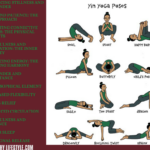Mountain Pose (Tadasana): Benefits and Safety Tips
Mountain Pose, known as Tadasana in Sanskrit, is a foundational yoga posture that serves as the starting point for many other asanas. Despite its seemingly simple nature, this pose offers a range of benefits for the body and mind. In this article, we will explore the advantages of practicing Mountain Pose and provide essential safety tips to ensure a fulfilling and injury-free experience.
Table of Contents
- Introduction to Mountain Pose (Tadasana)
- The Alignment and Technique of Mountain Pose
- Benefits of Mountain Pose
- Improves Posture
- Enhances Body Awareness
- Increases Strength and Stability
- Promotes Relaxation
- Precautions and Safety Tips
- Avoid Hyperextension
- Modify for Existing Conditions
- Engage Core Muscles
- Step-by-Step Guide to Practicing Mountain Pose
- Incorporating Mountain Pose Into Your Yoga Routine
- Conclusion: Embrace the Strength of the Mountain
Introduction to Mountain Pose (Tadasana): Benefits and Safety Tips
Mountain Pose, often described as the foundation of all standing poses, embodies the qualities of stability, strength, and stillness. It may appear as a simple stance, but when practiced mindfully, it becomes a powerful tool for cultivating mindfulness, balance, and an overall sense of well-being.
The Alignment and Technique of Mountain Pose
To practice Mountain Pose correctly, follow these steps:
- Stand upright with your feet hip-width apart and parallel to each other.
- Distribute your weight evenly across the soles of your feet.
- Engage your thigh muscles slightly to avoid locking your knees.
- Lengthen your spine, imagining a straight line from your tailbone to the crown of your head.
- Relax your shoulders, allowing them to roll back and down.
- Extend your arms alongside your body with your palms facing forward or bring your palms together at your heart center.
Benefits of Mountain Pose
Improves Posture
Mountain Pose promotes proper alignment of the spine, helping to correct and maintain good posture. It encourages you to stand tall with shoulders back, reducing the strain on your back and neck.
Enhances Body Awareness
By focusing on the alignment of your body and the sensations you feel in each part, you cultivate a heightened sense of body awareness, which can extend into other areas of your life.
Increases Strength and Stability
Maintaining the pose requires engaging various muscles, particularly those in the legs, core, and back. Over time, this can lead to increased muscular strength and overall stability.
Promotes Relaxation
Despite its active elements, Mountain Pose is also deeply relaxing. It allows you to connect with your breath, release tension, and experience a sense of calm.
Precautions and Safety Tips
Avoid Hyperextension
While extending your spine is essential, avoid excessive arching of the lower back. Keep a gentle engagement of the abdominal muscles to support your lower spine.
Modify for Existing Conditions
If you have any pre-existing medical conditions or injuries, consult a qualified yoga instructor before attempting Mountain Pose. They can help you modify the pose to suit your needs.
Engage Core Muscles
To protect your lower back, engage your core muscles throughout the pose. This not only provides stability but also prevents overextension.
Step-by-Step Guide to Practicing Mountain Pose
- Begin in a standing position with your feet hip-width apart.
- Press evenly through your feet while lifting your toes slightly.
- Engage your thigh muscles and gently tuck your tailbone.
- Lengthen your spine and roll your shoulders back and down.
- Breathe deeply and hold the pose for several breaths, focusing on your alignment and the sensations in your body.
Incorporating Mountain Pose Into Your Yoga Routine
Mountain Pose can be practiced on its own as a grounding exercise or incorporated into your yoga routine as a starting point for other poses. It’s an excellent way to center yourself before moving into more dynamic sequences.
Conclusion: Embrace the Strength of the Mountain
Mountain Pose is more than just a physical stance; it embodies qualities that can enrich your yoga practice and your life. By practicing this pose regularly and mindfully, you cultivate a strong foundation for both your physical and mental well-being.
For more Access Now: https://healthylifestyel.com/precautions-and-tips-for-practicing-yoga-safely/
https://healthylifestyel.com/why-do-i-lose-so-much-hair-when-i-comb-it/
https://healthylifestyel.com/7-types-of-yoga-and-their-focus/
Stand tall like a mountain, embodying strength, stability, and tranquility. Through Mountain Pose, you can find balance within yourself and discover the profound benefits it offers for your body and mind
Frequently Asked Questions (FAQ) on Mountain Pose (Tadasana)
As a foundational yoga posture, Mountain Pose (Tadasana) holds both simplicity and significance. To provide you with a clearer understanding, here are answers to some frequently asked questions about this pose.
1. What is Mountain Pose (Tadasana)?
Mountain Pose, or Tadasana, is a basic standing yoga posture that serves as the starting point for many other poses. It focuses on alignment, balance, and cultivating a sense of grounding.
2. What are the key benefits of practicing Mountain Pose?
Mountain Pose offers several benefits, including improved posture, enhanced body awareness, increased strength and stability, and a promotion of relaxation and calmness.
3. Can Mountain Pose help improve my posture?
Yes, Mountain Pose can greatly contribute to better posture by aligning the spine, shoulders, and hips. Regular practice can help you become more mindful of your body’s alignment even outside of your yoga practice.
4. How does Mountain Pose enhance body awareness?
By focusing on your body’s alignment, sensations, and breath while in Mountain Pose, you develop a heightened awareness of your physical presence. This mindfulness can extend to your everyday activities.
5. Is Mountain Pose suitable for beginners?
Absolutely. Mountain Pose is an excellent starting point for beginners as it introduces foundational alignment principles that are applicable to more complex poses.
6. Can I practice Mountain Pose if I have existing back issues?
It’s advisable to consult a qualified yoga instructor or healthcare professional before attempting Mountain Pose with existing back issues. They can guide you on modifications to ensure your safety and comfort.
7. How does Mountain Pose promote relaxation?
While Mountain Pose requires engagement of various muscle groups, it also encourages relaxation through deep breathing and the release of tension in the shoulders and neck.
8. Can I practice Mountain Pose during pregnancy?
Yes, Mountain Pose can be practiced during pregnancy with modifications. However, it’s crucial to consult a prenatal yoga instructor to ensure the pose is adapted for your changing body.
9. Is it necessary to engage the core muscles in Mountain Pose?
Engaging the core muscles in Mountain Pose provides stability to the spine and pelvis, helping you maintain proper alignment and prevent overextension.
10. How can I incorporate Mountain Pose into my daily routine?
You can integrate Mountain Pose into your daily routine by using it as a grounding exercise upon waking up or as a brief moment of centering before starting your day.
11. Can Mountain Pose be practiced outside of a yoga session?
Absolutely. Mountain Pose can be practiced anytime, anywhere. It’s a wonderful way to recalibrate your posture and mindset throughout the day.
12. Is it normal to feel a sense of tranquility in Mountain Pose?
Yes, many practitioners experience a sense of tranquility and inner stillness in Mountain Pose. This is often a result of the focus on breath and alignment.
13. How long should I hold Mountain Pose?
You can start by holding Mountain Pose for several breaths, gradually increasing the duration as you become more comfortable and familiar with the posture.
14. Can Mountain Pose be combined with other poses?
Yes, Mountain Pose can be a starting point for various standing poses and sequences, making it a versatile cornerstone of your yoga practice.
15. What is the symbolism behind the name “Mountain Pose”?
Just as a mountain stands tall and unwavering, Mountain Pose represents the qualities of strength, stability, and groundedness











